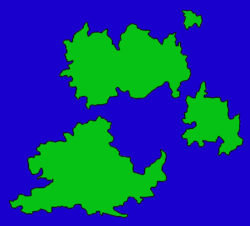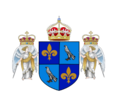Fleischland

The Republic of Fleischland, commonly known as Fleischland is a country composed of three major islands, 10 states, and 8 crown colonies. Fleischland is a republic and social democracy. The capital is Oakland and the largest city and economic center is Grand City. The Monarchal Republic of Fleischland descended from the Kingdom of Fleischland in 1830 with the establishment of Congress and the adoption of The Constitution.
The Republic of Fleischland | |||||||
|---|---|---|---|---|---|---|---|
| Motto: Virtute et votes By Virtue and Vows | |||||||
| Anthem: God Save the King | |||||||
 | |||||||
| Capital | Oakland | ||||||
| Largest city | Grand City | ||||||
| Demonym(s) | Fleischlandian | ||||||
| Government | Constitutional Monarchy, Republic, Social Democracy | ||||||
| Ben Fleischman | |||||||
• Speaker of The House | John Peters | ||||||
• Speaker of The Senate | Gregory Randolph | ||||||
| Legislature | Congress | ||||||
| Senate | |||||||
| House of Representatives | |||||||
| Establishment | |||||||
• Formation of the Monarchal Republic | 1830 | ||||||
• Adoption of The Constitution | 1831 | ||||||
| Population | |||||||
• 2023 estimate | 577,600,000 | ||||||
| Currency | Fleischlandic Standard Dollar (FSD) | ||||||
| |||||||
Etymology
The name Fleischland refers to the people living within the four Fleischlandic islands.
History
The First Fleischlandic Dynasty
The Second Fleischlandic Dynasty
The Kingdom of Fleischland
The Monarchal Republic of Fleischland
The Republic of Fleischland
Politics and government
Executive Branch
The executive branch is responsible for enforcing laws. It consists of the President, who is the head of state and government, and the Cabinet, which is composed of the heads of various government departments. The President is elected for a four-year term and is responsible for appointing members of the Cabinet, enforcing laws, and serving as commander-in-chief of the military.
| President | |
|---|---|
| Title | Mr. President, His Excellency |
| Qualifications | At least 18 years old; citizen of Fleischland |
| Method of Election | Directly elected by a nationwide popular vote |
| Role | Leader of the Fleischlandic Government, Commander and Chief of the Fleischlandic Armed Forces, Chief Diplomat... |
Legislative Branch
The legislative branch is responsible for making laws. It consists of a bicameral parliament, which is divided into the House of Representatives (lower house) and the Senate (upper house). The House of Representatives has 722 members, while the Senate has 200 members. The members of the House of Representatives are elected every two years, while members of the Senate are elected for six-year terms. The legislative branch is responsible for passing laws, approving budgets, and conducting investigations.
| Branch | House of Representatives | Senate |
|---|---|---|
| Number of Members | 722 | 200 |
| Term Length | 4 years | 4 years |
| Qualifications | At least 18 years old; citizen of Fleischland | At least 18 years old; citizen of Fleischland |
| Method of Election | Directly elected by district; every 800,000 citizens represented by one member | Directly elected statewide; each state has half as many Senators as Representatives |
| Leadership | Speaker of the House elected by the House members | Speaker of the Senate elected by the Senate members |
| Representation | A member represents roughly 800,000 people. | A member roughly represents 2,888,000 people. |
Judicial Branch
The judicial branch is responsible for interpreting laws. It consists of the Supreme Court, which is the highest court in the land, and several lower courts. The Supreme Court is composed of 13 justices who are appointed by the President and confirmed by both the House of Representatives and the Senate. The justices serve for a term of 18 years and cannot serve again after that period. The judicial branch is responsible for interpreting laws, resolving disputes, and upholding the Constitution.
Political parties
The political landscape of Fleischland is characterized by a diverse range of political ideologies and beliefs. The dominant political parties are the Liberal Progressive Union (LPU) and the Compassionate Conservative Party (CPCP), which represent the center-left and center-right respectively. The LPU advocates for social democracy, liberal values, and progressive policies, while the CPCP supports conservative values, limited government intervention, and economic liberalism.
In addition to these two major parties, there are several smaller parties that represent a variety of political ideologies. The Independent Left Party (ILP) represents humanism and social progressivism, while the Social Equality Party (SEP) focuses on equality for all, feminism, and anti-racism. The Intellectual Party (IP) emphasizes education reform and innovation, and the Green Party (GP) advocates for environmental protection and sustainability.
There are also some parties that are considered to be on the far-right and far-left of the political spectrum. The National Conservative Faction (NCF) represents nationalist and authoritarian views, while the Fleischlandic Socialist Party (FCP) advocates for a socialist economy and a more equal distribution of wealth.
States
Explain your nation's claim system, and the various types of constituencies your nation may have, for example, the difference between a district and a territory. It is preferred that you do not discuss each constituency in this section. Instead, the names of each constituency in the table should be linked to their own separate articles. You can add and remove columns as you wish, but generally, include fields for the flags (which should be kept small, 100px wide, less if more rows listed, and have a border), name, and important fields such as area, population, and/or representative, governor, or similar position. You do not need to include a column for a seal, flag, or coat of arms for each constituency if it they do not have one.
| Flag | Arms (optional) |
Name | Area | Population | Officials | |
|---|---|---|---|---|---|---|
| {Constituencies} | ||||||

|
Example District | |||||
| {Second type of constituencies} | ||||||

|
Example Territory | |||||
Geography and climate

Use this section to write about the terrain, climate, weather, and location of your micronation. A good template for listing annual temperature data is {{Weather box}}.
Economy
((INSERT FISCAL INFORMATION, LIKE EXPORTS, IMPORTS, INDUSTRIES, ETC.))
Culture and media
((INSERT INFORMATION ABOUT THE HOLIDAYS, CUSTOMS, EDUCATION, LANGUAGE(S), THE ARTS, THE PRESS, TELEVISION, ETC.))
Holidays
It is recommended to use the following table for holidays:
| Date | Name | Remarks |
|---|---|---|
| 1 January 1970 | Unix Epoch Time day |
See also
Related pages, in a bulleted list.
Notes
Only include this section if using {{Efn}}. This section should only contain {{Notelist}}
References
This section should only contain {{Reflist}}.
External links
External links are for, well, links to external sites. These can include your nation's official site, citizenship application, and social media links. Links should be added in a bulleted list, for example:
MAKE SURE TO ADD NECESSARY CATEGORIES TO YOUR PAGE HERE, AS SUCH: [[Category:{short name of micronation}]], [[Category:Micronations in {country/macronation}]], [[Category:Micronations in {state or other subdivision, if applicable}]], [[Category:Micronations established in {year}]]









